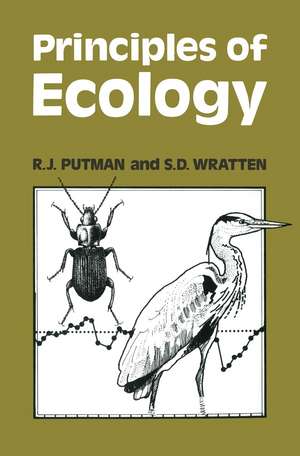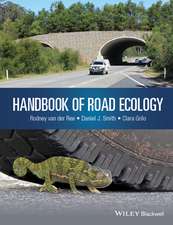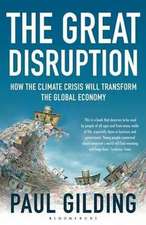Principles of Ecology
Editat de Rory Putmanen Limba Engleză Paperback – apr 1983
Preț: 644.82 lei
Preț vechi: 758.60 lei
-15% Nou
Puncte Express: 967
Preț estimativ în valută:
123.38€ • 129.17$ • 102.09£
123.38€ • 129.17$ • 102.09£
Carte tipărită la comandă
Livrare economică 07-21 aprilie
Preluare comenzi: 021 569.72.76
Specificații
ISBN-13: 9780412319303
ISBN-10: 0412319306
Pagini: 388
Ilustrații: 388 p. 50 illus.
Dimensiuni: 155 x 235 x 20 mm
Greutate: 0.54 kg
Ediția:1984
Editura: SPRINGER NETHERLANDS
Colecția Springer
Locul publicării:Dordrecht, Netherlands
ISBN-10: 0412319306
Pagini: 388
Ilustrații: 388 p. 50 illus.
Dimensiuni: 155 x 235 x 20 mm
Greutate: 0.54 kg
Ediția:1984
Editura: SPRINGER NETHERLANDS
Colecția Springer
Locul publicării:Dordrecht, Netherlands
Public țintă
ResearchCuprins
1: The Organism and its Environment.- 1.1 The organism and its abiotic environment: limits to tolerance.- 1.2 Interactions between environmental variables.- 1.3 Macro-environment and micro-environment.- 1.4 Adjustment of tolerance limits.- 1.5 Homeostasis: avoidance of the problem.- 1.6 Behavioural mechanisms for homeostasis.- 1.7 Adaptive suites.- 1.8 Organism and abiota: a two-way interaction.- 2: The Ecological Community.- 2.1 Introduction.- 2.2 Communities and ecosystems.- 2.3 Biotic relationships.- 2.4 The organism in the community.- 2.5 The community level of organisation.- 2.6 Tropho-dynamic analyses.- 2.7 Community structure.- 2.8 Analyses of food web design.- 2.9 Subcompartments in community structure.- 2.10 Common denominators of community design.- 2.11 Species-abundance relationships.- 2.12 Species associations.- 2.13 Niche relationships and design rules.- 2.14 The structure of particular communities.- 2.15 Community flux.- 3: Community Dynamics.- 3.1 Introduction.- 3.2 The community as a system of energy transformations.- 3.3 Energy relationships of individuals.- 3.4 Energy relationships in the community.- 3.5 Energy flow within the community: the tropho-dynamic approach.- 3.6 Limitations of energy analysis.- 3.7 The flow of nutrients within communities.- 3.8 The importance of the decomposers.- 4: Temporal Change in Community Structure and Function.- 4.1 Introduction.- 4.2 Short-term cycles in community structure.- 4.3 Shifts in community structure: colonisation and extinction.- 4.4 Succession.- 4.5 Characteristics of succession.- 4.6 The mechanics of succession.- 4.7 What stops the successional process?.- 4.8 Climax communities.- 4.9 Succession as a necessary mathematical consequence.- 5: The Concept of the Niche.- 5.1 Introduction and definition of niche.-5.2 Parameters of the niche.- 5.3 Factors affecting the niche and its parameters.- 5.4 Niche separation.- 5.5 Niche overlap.- 5.6 Measures of niche width, separation and overlap.- 5.7 Niche relationships and community structure.- 5.8 Parallel niches.- 6: Interspecific Competition and Community Structure.- 6.1 Introduction and definitions of competition.- 6.2 Interspecific competition.- 6.3 The mechanics of competition.- 6.4 Niche overlap and competition.- 6.5 The effects of interspecific competition within the community: exclusion and coexistence.- 6.6 Diffuse competition and indirect competitive effects.- 6.7 Competition as a selection pressure promoting change.- 6.8 Niche shifts and evolutionary change due to competition.- 6.9 Interspecific competition in natural systems.- 7: Population Structure and Analysis.- 7.1 What is population ecology?.- 7.2 Theoretical population growth.- 7.3 The analytic (life table) approach.- 7.4 Simulation of population events.- 7.5 Towards a general population theory.- 8: Competition and Population Stability.- 8.1 Introduction: inter and intra-specific competition and population stability.- 8.2 Regulation in vertebrate populations.- 8.3 Population cycles in vertebrates.- 8.4 Population cycles in invertebrates.- 9: Predators, Parasitoids and Population Stability.- 9.1 Why study predators and parasitoids?.- 9.2 Analytical models and the components of prédation.- 9.3 Predator development and accumulation.- 9.4 A theoretical basis for biological control.- 9.5 Polyphagous predators and analytical models.- 9.6 Field studies of the role of polyphagous predators.- 9.7 The effects of prédation on prey productivity and community structure.- 10: Evolution and Adaptation.- 10.1 Evolution and ecology.- 10.2 Adaptation.- 10.3 Bionomic strategies.-10.4 Implications of r- and K-selection.- 10.5 Adaptiveness of foraging strategy.- 10.6 Optimal foraging.- 10.7 Reproductive strategy.- 10.8 Adaptiveness of social group.- 10.9 Optimality and evolutionarily stable strategies.- 10.10 The evolution of stable strategies.- 11: Coevolution.- 11.1 Insect-plant interactions.- 11.2 Larger herbivores.- 11.3 Interaction of plant-herbivore populations.- 11.4 Coevolution to mutualism.- 11.5 Coadapted systems.- 12: Species Diversity.- 12.1 Diversity as a descriptor of ecological communities.- 12.2 Measures of diversity.- 12.3 Resolution of chaos in diversity indices.- 12.4 The S component of diversity: why are there so many kinds of organisms?.- 12.5 Colonisation, extinction and island biogeography.- 12.6 Saturation point.- 12.7 Equitability.- 12.8 Factors promoting species diversity.- 12.9 Theories of diversity.- 13: Stability.- 13.1 Definitions.- 13.2 Stability of single species populations.- 13.3 Stability of two or three species systems.- 13.4 Community stability.- 13.5 Diversity and stability.- 13.6 May’s Paradox.- 13.7 Stability and food web design.- 13.8 The energetics of stable systems.- 13.9 Causes for stability.- References.- Acknowledgements.














